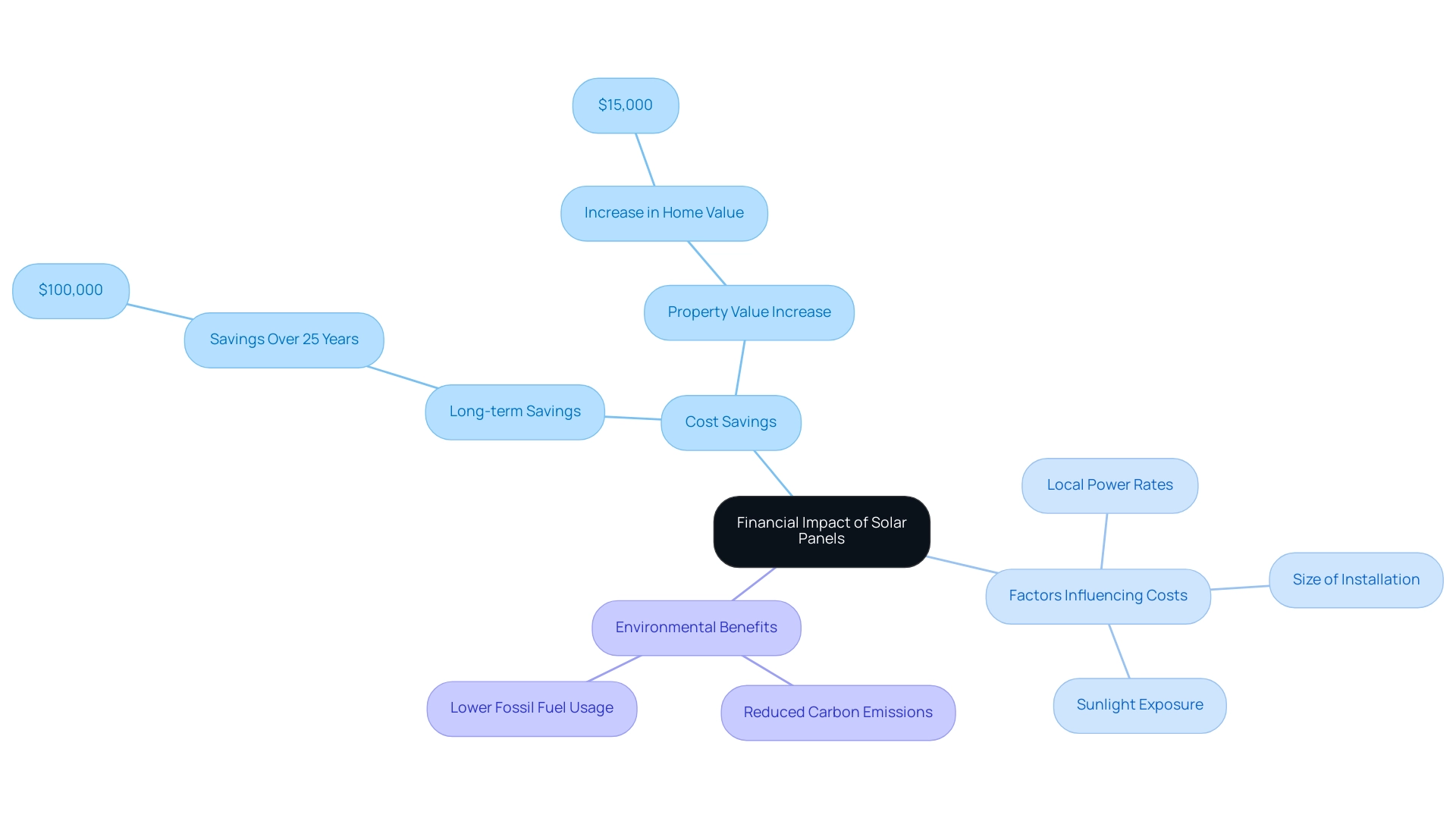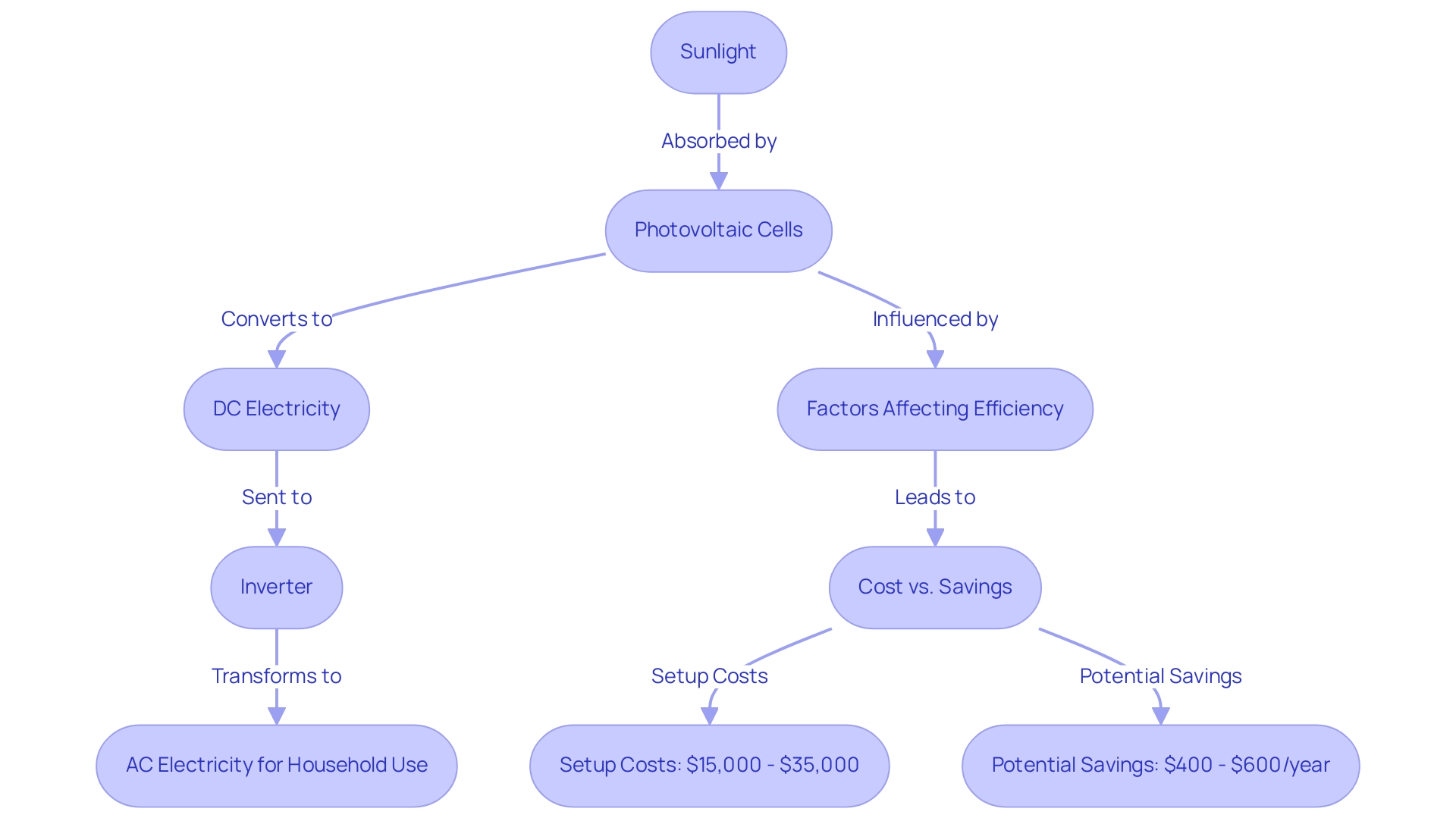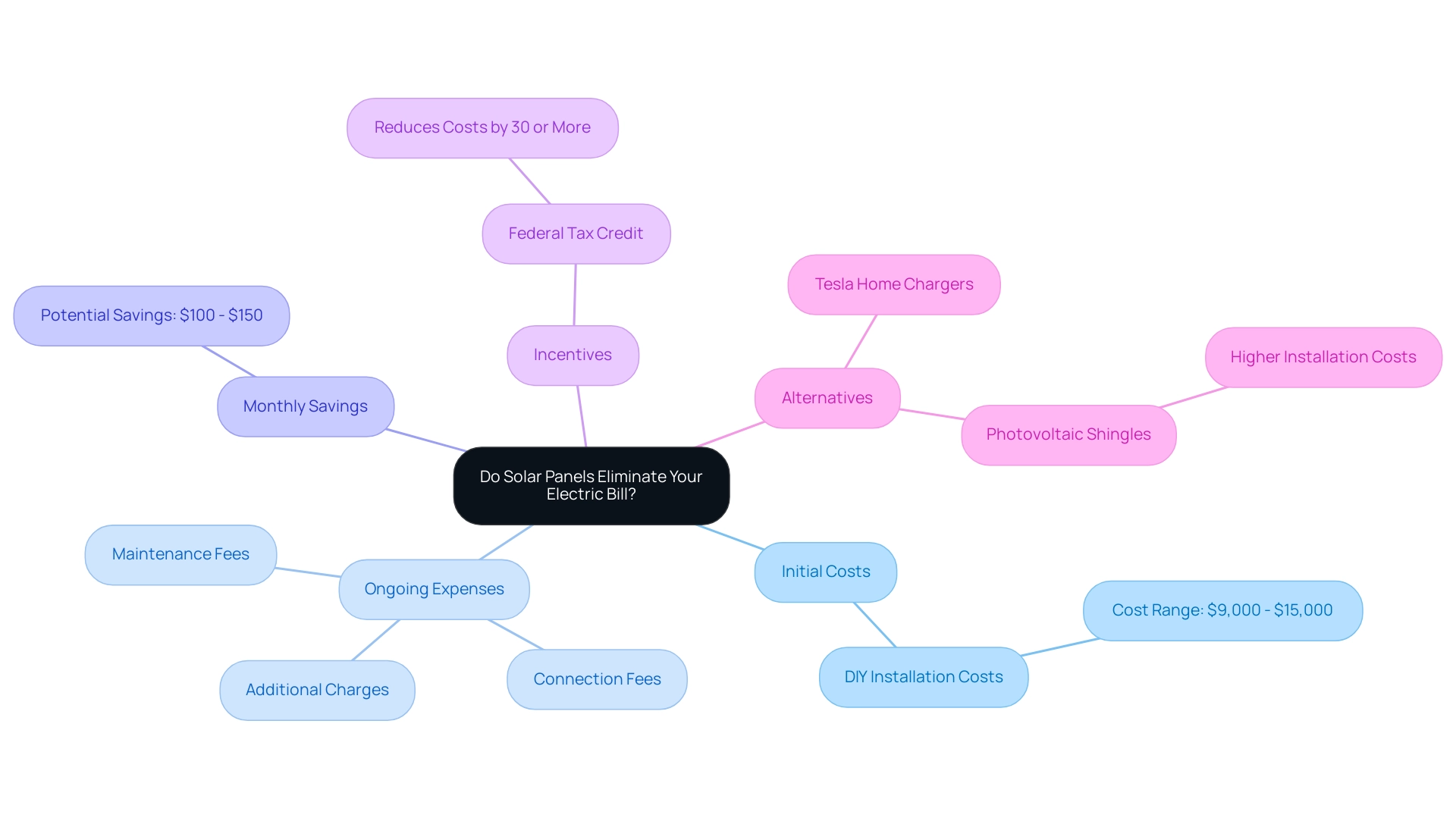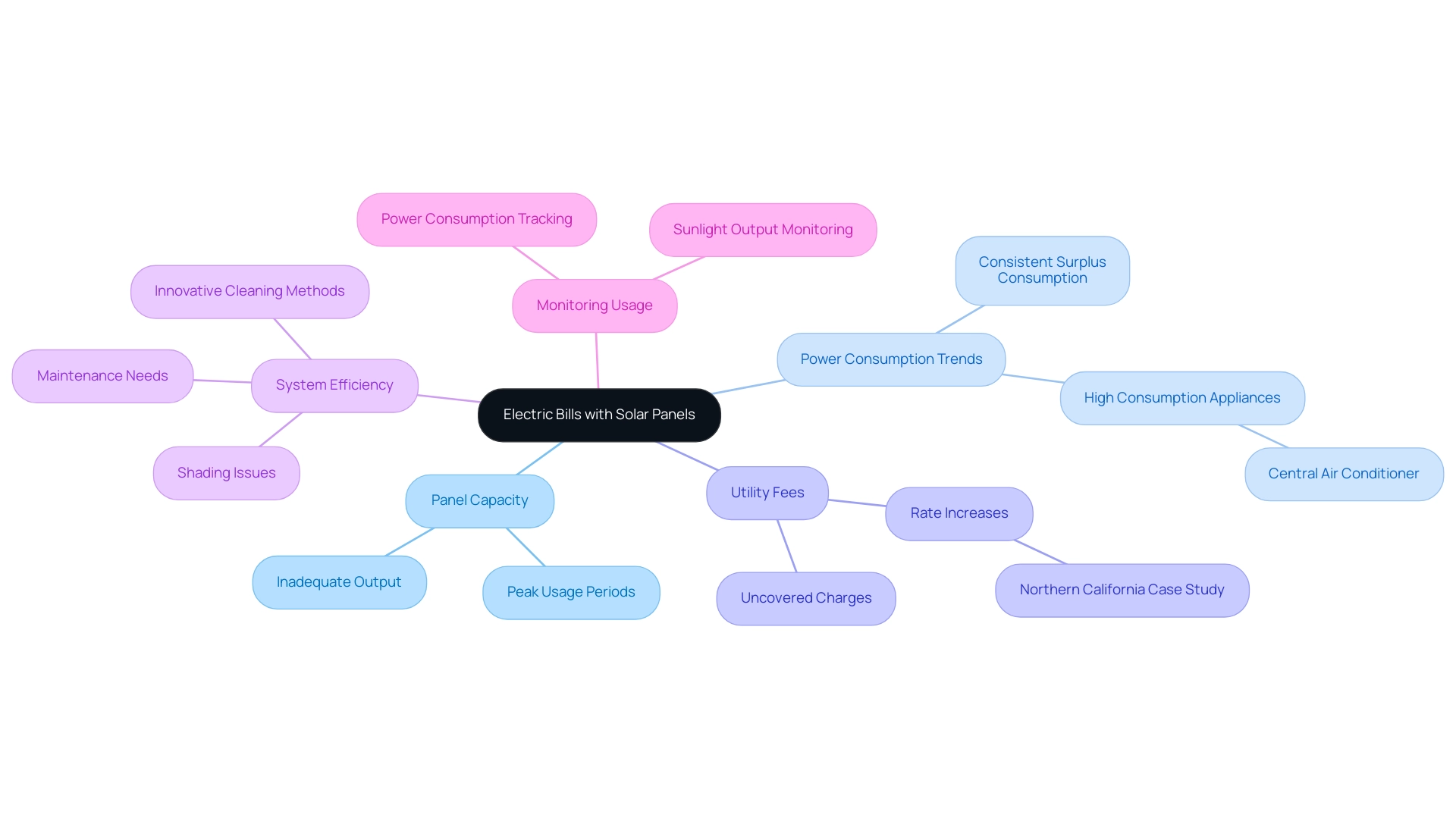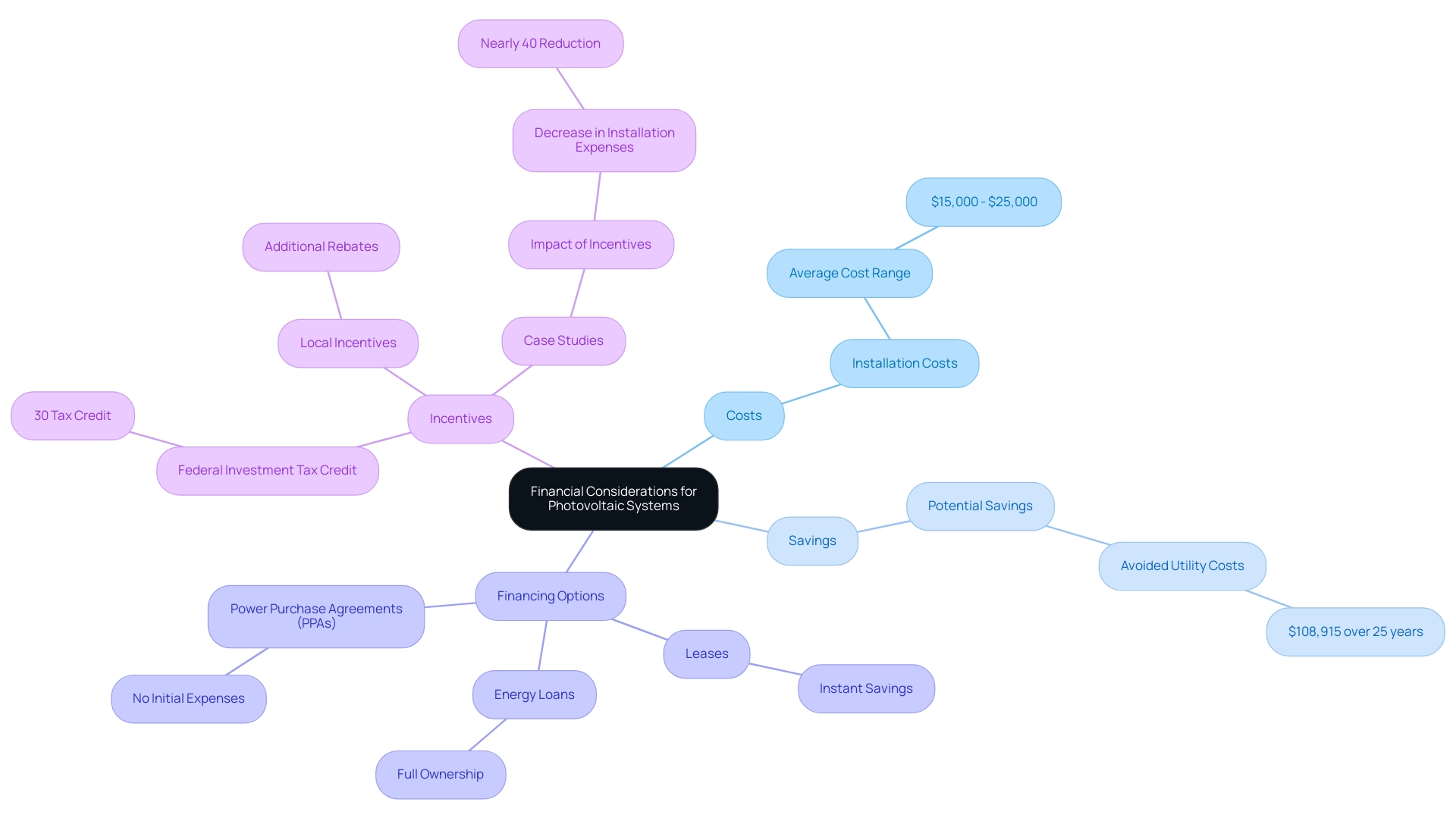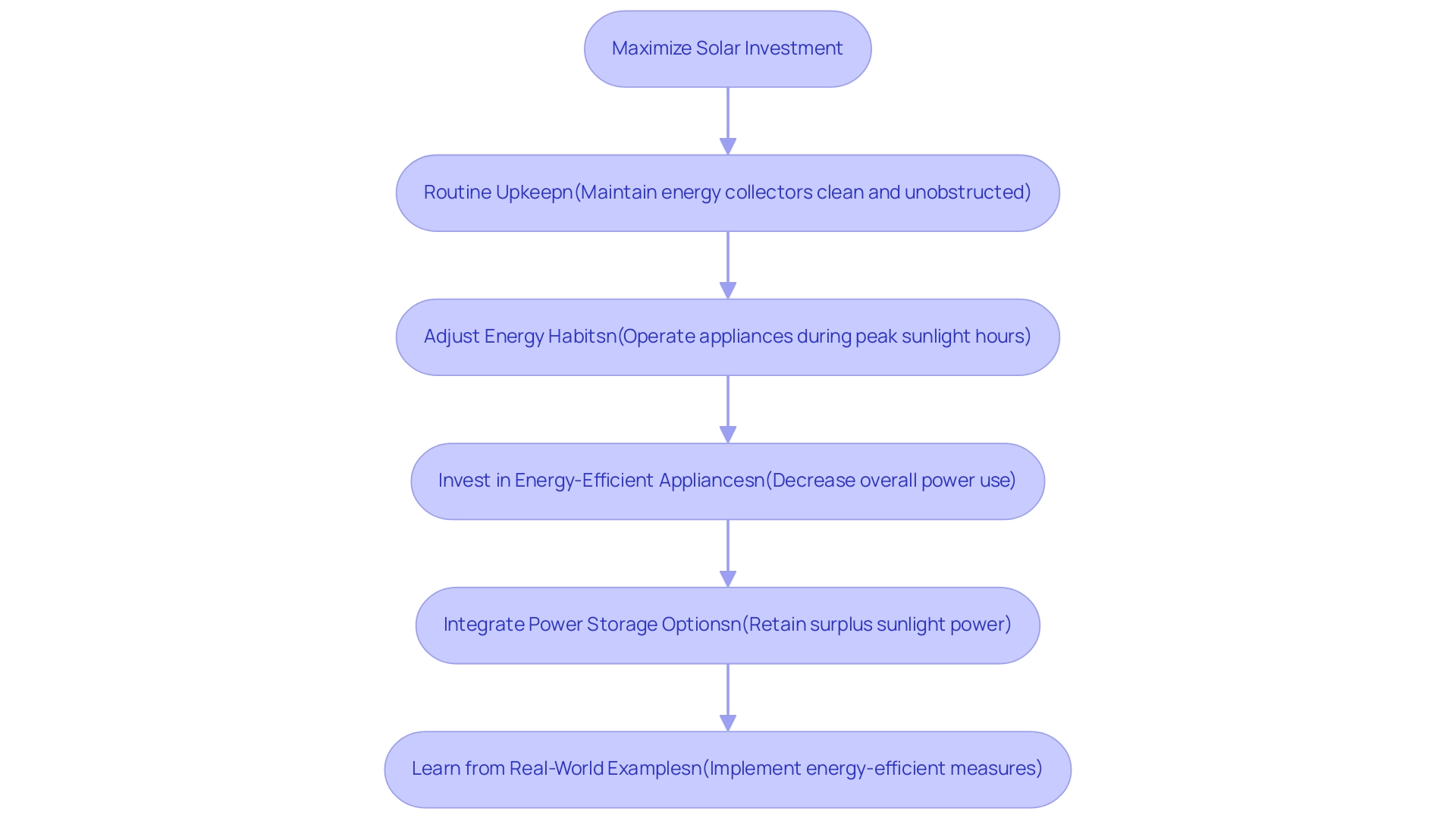Overview
We understand that homeowners often face concerns about rising electricity bills. While those with solar panels typically still pay for electricity, many find that their bills are significantly reduced thanks to the energy produced by their systems.
It’s common to feel overwhelmed by connection charges and additional electricity costs, but the reality is that many users experience substantial savings—potentially over $100 monthly—by generating their own power.
By utilizing net metering to offset grid consumption, they not only ease their financial burden but also embrace a path towards energy independence.
Together, we can explore the financial benefits of adopting solar energy, ensuring that you feel supported and guided every step of the way.
Introduction
As the world shifts towards sustainable energy solutions, solar panels shine as a beacon of hope for eco-conscious homeowners who are eager to reduce their carbon footprint and lower their electricity bills. We understand that many are left wondering: can solar panels truly eliminate their electricity costs? While the potential for substantial savings exists, the reality is more nuanced. Homeowners often still face connection fees, taxes, and charges for any additional energy consumed beyond what their solar systems produce.
This article delves into the intricacies of solar energy, exploring:
- How it works
- The financial implications of installation
- The factors that influence ongoing electricity costs
With insights into net metering, energy storage, and practical tips for maximizing solar investments, readers will gain a comprehensive understanding of how to navigate the world of solar energy and make informed decisions for their homes. Together, we can work towards a more sustainable future.
The Basics of Solar Panels and Electricity Bills
Are you wondering about the financial impact of installing solar panels? Many environmentally conscious residents share this concern, particularly regarding whether they still pay for electricity if they have solar panels. It’s common to feel uncertain about these matters, but rest assured, photovoltaic systems can significantly reduce your utility expenses while also offering a sustainable power source for your home.
While it’s true that homeowners with photovoltaic installations may still face connection charges and could pay for any electricity used beyond what their system generates, the potential savings are remarkable. In fact, data suggests that property owners can save over $100,000 on power expenses over 25 years with photovoltaic systems. This highlights the long-term financial advantages of embracing renewable energy.
Several factors influence electricity costs for those utilizing photovoltaic systems, including the size of the installation, local power rates, and the amount of sunlight received. A well-sized photovoltaic system can meet a substantial portion of a household’s energy needs. However, variations in energy consumption and seasonal changes might lead to some reliance on grid electricity. Importantly, these systems not only provide monetary savings but also contribute to a cleaner environment by lowering carbon emissions and reducing fossil fuel usage.
Many homeowners report experiencing reduced electricity costs after installing solar panels, which raises the question: if I have solar panels, do I still pay for electricity? The answer is yes, but the bill is typically much lower. A case study on distributed photovoltaic systems illustrates how these installations are transforming electricity markets, driven by decreasing costs and supportive policies. Still, challenges exist, such as the need for tariff reforms to adapt to the changing landscape of energy consumption.
In 2023, global investments in photovoltaic capacity expansions exceeded USD 480 billion, marking a record year for investment and underscoring the growing significance of renewable energy. Moreover, research from the Lawrence Berkeley National Laboratory reveals that photovoltaic installations can enhance a home’s value by approximately $15,000, further emphasizing the economic benefits of adopting solar power. While some property owners with photovoltaic systems may still incur electricity charges, the overall savings and increased property value make solar technology an attractive option for those looking to enhance their energy independence and reduce their carbon footprint.
If you’re considering making the switch to solar, local companies in Stockton, California, are ready to provide the guidance and support you need. Together, we can navigate your energy solutions and help you make informed choices that benefit both your wallet and the environment.
How Solar Panels Generate Electricity for Your Home
Are you feeling overwhelmed by rising energy bills? Solar modules offer a compassionate solution by harnessing the power of sunlight through photovoltaic (PV) cells, which convert sunlight into direct current (DC) electricity. This DC electricity is then transformed into alternating current (AC) by an inverter, making it suitable for your household appliances. On average, a residential photovoltaic power system can produce between 5 to 15 kilowatts of electricity daily, depending on several factors such as system size, efficiency, and local sunlight exposure.
Understanding the efficiency of photovoltaic systems, usually ranging from 15% to 22%, is vital for determining how much electricity is generated. High thermal efficiency ratings indicate how effectively a setup transforms sunlight into usable heat, which is essential for maximizing energy output. Imagine a properly optimized photovoltaic panel system that can significantly reduce your dependence on the grid, prompting the question: if I have solar panels, do I still pay for electricity? This can lead to considerable savings on your electricity expenses.
According to estimates from the Energy Department, solar-powered water heating systems can save residents between $400 to $600 each year on utility expenses. While setting up a residential power system typically ranges from $15,000 to $35,000, the long-term savings can counterbalance this initial expenditure, making renewable power a financially feasible choice for many homeowners.
Photovoltaic cells work by absorbing photons from sunlight, exciting electrons, and generating an electric current. This process is influenced by various factors, including the angle of the panels, shading from nearby structures, and the geographic location of your home. For instance, homes in sunnier regions can expect higher electricity generation compared to those in areas with frequent cloud cover.
Additionally, integrating photovoltaic battery backups is crucial for ensuring reliable energy during power outages and adverse weather conditions, enhancing your energy independence.
Recent case studies highlight the growing efficiency of photovoltaic cells in residential systems. As of 2023, companies accounted for 25% of the total installed PV capacity, driven by advancements in technology and supportive policies. This trend underscores the importance of ongoing research and development in photovoltaic technology to achieve further efficiency improvements and cost savings.
As Ben Zientara, a Policy Analyst for renewable energy, notes, “The easiest way to determine how much the panels can save you is by using our panel savings calculator below.”
Moreover, global photovoltaic investments in capacity additions increased by about 30% in 2023, surpassing USD 480 billion, marking a record year for investment. This increasing trend highlights the significance of renewable power as a sustainable answer to escalating utility expenses and its contribution to decreasing greenhouse gas emissions. For example, utilizing heating systems powered by the sun can prevent 2 tons of carbon dioxide from entering the atmosphere annually, contributing to a healthier planet.
In conclusion, photovoltaic systems not only provide a renewable power source but also empower homeowners to manage their energy usage. This leads to the question: if I have solar panels, do I still pay for electricity? Ultimately, this can result in lower electricity expenses, improved independence in power supply, and a notable positive impact on our ecosystem. Together, we can work towards a brighter, more sustainable future.
Do Solar Panels Eliminate Your Electric Bill?
While photovoltaic panels can significantly reduce electricity expenses, many homeowners wonder, if I have solar panels, do I still pay for electricity entirely? It’s common to encounter recurring expenses such as connection fees, taxes, and charges for any power used beyond what your renewable system produces. For instance, a typical 5 kW residential photovoltaic system can save residents between $100 to $150 each month on electric expenses, depending on factors like energy usage patterns and local utility rates.
Moreover, during periods of low sunlight—like cloudy days or nighttime—residents may need to draw electricity from the grid. This raises the question, if I have solar panels, do I still pay for electricity? Such scenarios can lead to additional charges, which is a significant consideration for homeowners who question their ongoing electricity costs even after installing photovoltaic panels. A case study titled ‘Financing and Roof Replacement Considerations’ emphasizes that understanding financing options and potential roof replacements can greatly influence the overall investment in renewable energy.
It’s essential for homeowners to be aware that DIY energy installation costs typically range between $9,000 and $15,000. Considering these initial expenses alongside ongoing costs is crucial for making informed decisions.
Expert insights suggest that homeowners should also be mindful of various ongoing costs associated with photovoltaic panel ownership. These can include maintenance fees, potential inverter replacements, and expenses for energy consumed when production is insufficient. This leads to the inquiry: if I have solar panels, do I still pay for electricity? Additionally, financial advisors emphasize that comparing multiple quotes can lead to savings of up to 20%, further enhancing the financial viability of investments in renewable energy.
Furthermore, renewable energy incentives and rebate programs, including the federal tax credit, can lower installation expenses by 30% or more. Understanding these potential savings is vital for property owners.
In addition to conventional photovoltaic systems, homeowners might explore options like Tesla home chargers and photovoltaic shingles, which provide distinct advantages and disadvantages. For example, Tesla home chargers facilitate efficient EV charging, while solar roof shingles offer an attractive alternative to traditional structures but may involve higher installation costs. Investigating these choices can provide valuable insights into efficiency integration and long-term sustainability.
Ultimately, while photovoltaic systems offer a pathway to reduce energy costs, it’s crucial for property owners to consider, if I have solar panels, do I still pay for electricity? This reflection is essential for planning ongoing expenses, effectively assessing savings, and managing energy expenditures.
Understanding Net Metering and Its Impact on Your Bill
Net metering is an essential billing system that allows property owners with photovoltaic panels to earn credits for the excess electricity they produce and supply back to the grid. You might wonder, if I have solar panels, do I still pay for electricity? This system enables homeowners to significantly reduce their electricity expenses, particularly during peak production periods on sunny days. When sunlight production peaks, many property owners find themselves asking, if I have solar panels, do I still pay for electricity? The good news is that they can lower their utility costs by earning credits for the surplus power supplied to the grid.
So, if I have solar panels, do I still pay for electricity? These credits can be applied to future electricity bills, which is especially beneficial during months when energy production may dip. Understanding the financial implications of net metering is crucial, particularly when considering the question, if I have solar panels, do I still pay for electricity? For instance, property owners who take advantage of net metering often experience significant savings that greatly reduce their overall utility expenses, leading to the important question: if I have solar panels, do I still pay for electricity? In California, existing net metering regulations have been established to assist users of renewable sources, enabling them to optimize their investment.
A recent analysis revealed that residential customers under the NEM 2.0 program paid considerably less post-installation compared to their estimated service costs, reinforcing the question of if I have solar panels, do I still pay for electricity? This showcases the effectiveness of net metering in reducing electricity expenses. Furthermore, participating in initiatives such as Sunnova’s Demand Side Grid Support can provide additional savings, with promoted benefits of $125 each year.
Insights from policy specialists highlight that net metering not only supports individual homeowners but also contributes to a more sustainable power grid. By encouraging the generation of sunlight-based power, net metering promotes the use of renewable resources, ultimately decreasing dependence on fossil fuels. Focus groups conducted as part of the NEM 2.0 evaluation have emphasized the importance of these policies in enhancing consumer protection and promoting renewable energy adoption.
Case studies further illustrate the advantages of net metering. For example, a comparative analysis of utility bills for residential and nonresidential customers under the NEM 2.0 framework showed that while residential users enjoyed lower costs, nonresidential customers continued to face higher expenses, with an estimated $288.0 million more paid pre-installation and still $117.5 million more post-installation. This dynamic underscores the significance of understanding net metering, particularly in the context of the question, if I have solar panels, do I still pay for electricity? It serves as a tool for financial savings and autonomy.
As Ryan Suchsland, a residential consultant, observes, ‘Net metering not only offers prompt financial assistance but also enhances the confidence between providers and property owners, promoting a more sustainable power future.’ In summary, net metering serves as a vital mechanism for homeowners to capitalize on their investments in renewable energy, addressing the concern of if I have solar panels, do I still pay for electricity, while providing both immediate financial relief and long-term sustainability benefits. This aligns with the broader context of sunlight solutions, including the financial advantages of incorporating photovoltaic systems and EV charging stations, such as Tesla home chargers, along with the importance of evaluating service providers like Powercore Electric to ensure the best value in sunlight solutions.
Why You Might Still Have an Electric Bill with Solar Panels
Homeowners with photovoltaic systems often wonder, if I have solar panels, do I still pay for electricity? This concern arises from several important factors. One main reason is the potential inadequacy of panel capacity to meet the household’s power needs. For instance, a central air conditioning unit can use roughly 2,000 kilowatt-hours of electricity each year, which may exceed the output of a standard household photovoltaic system, especially during peak usage periods.
Moreover, power consumption trends significantly impact this situation. If a household’s power consumption consistently surpasses the photovoltaic output, it raises the question: if I have solar panels, do I still pay for electricity? Residents will still rely on grid electricity, leading to increased expenses. Utility fees can further contribute to ongoing costs, as certain charges may not be fully covered by renewable generation. This is particularly true in areas experiencing recent rate increases, such as Northern California, where homeowners have expressed frustration over rising utility costs.
These rate increases have prompted many to seek solutions similar to those offered by Powercore Electric, a company that prides itself on personalized service and community support, including energy installations, battery backups, and EV charging stations.
Furthermore, the efficiency of the energy system itself is crucial. Factors like inadequate maintenance, shading from trees or buildings, and system inefficiencies can result in reduced power production. Routine upkeep and innovative cleaning methods, as outlined in our user guides, are essential for ensuring optimal performance and longevity of photovoltaic systems.
Homeowners should also monitor their power consumption alongside sunlight output to quickly identify and resolve issues. Expert insights suggest that understanding these dynamics is vital for panel owners. Mahelet G. Fikru noted that local policy plays a significant role in encouraging households towards renewable energy installation, positively impacting the number of installations.
By proactively managing their power usage and ensuring optimal system performance, property owners can minimize unexpected electricity expenses and maximize the benefits of their renewable investments. Powercore Electric’s commitment to helping residents navigate these challenges further enhances their ability to support clients in achieving independence in their power usage. For additional details on how to enhance your renewable power system, reach out to Powercore Electric today. Together, we can empower your journey towards sustainable energy solutions.
The Role of Energy Storage in Reducing Electricity Costs
Are you feeling overwhelmed by rising energy bills? Battery storage solutions, particularly photovoltaic batteries, can be a game changer for homeowners like you who wish to maximize renewable energy consumption. By capturing surplus power generated on sunny days, these systems allow you to store energy for use during peak demand times or at night when sunlight is no longer available. This capability can significantly reduce your reliance on the grid, prompting the question: if I have solar panels, do I still pay for electricity? The answer is often a resounding yes, as many homeowners experience substantial reductions in their electricity costs.
When considering a battery, it’s important to think about several key factors:
- Capacity
- Efficiency
- Lifespan
- Price
- Ecological benefits
Recent statistics reveal a growing trend among solar panel owners who are integrating storage solutions into their homes. Many report improved savings on their utility bills, leading to the common inquiry: if I have solar panels, do I still pay for electricity? In fact, property owners utilizing battery systems can save up to 50% on their electricity expenses by shifting their energy usage to off-peak hours. This is especially beneficial during peak demand periods when electricity rates are at their highest.
Real-world stories illustrate the effectiveness of battery systems in reducing grid dependence. For instance, one homeowner in California shared that after installing a battery, their reliance on the grid decreased by 70%, allowing them to enjoy uninterrupted power even during outages. Such experiences highlight the dual advantages of power storage, particularly when contemplating the question: if I have solar panels, do I still pay for electricity? The answer often leads to both cost reductions and greater autonomy.
Experts emphasize the critical role of power storage in enhancing renewable savings. Industry professionals note that incorporating battery systems not only maximizes the use of generated power but also provides a safeguard against fluctuating prices. As the renewable market expands, with forecasts predicting a 46% increase in deployment due to favorable policies like the Inflation Reduction Act, the adoption of storage systems is expected to rise accordingly.
Moreover, a recent survey indicated that 78% of installers foresee a rise in photovoltaic sales by 2025, reflecting the growing interest in renewable energy solutions. Major corporations, including Amazon, Google, and Meta, have a combined contracted pipeline exceeding 25 GW of photovoltaic capacity, underscoring the significance of renewable power adoption for homeowners considering storage solutions. Evaluating photovoltaic batteries—whether lead-acid, lithium-ion, or flow systems—provides valuable insights into the best choices for sustainable power storage.
In summary, storage systems present substantial benefits for photovoltaic homeowners, such as cost savings, enhanced reliability, and energy independence. As technology continues to advance and become more accessible, the potential for savings and efficiency will only increase, making battery systems a wise investment for those committed to sustainable practices. Ben Zientara, a Solar Policy Analyst, notes that the current political climate may influence the ease of photovoltaic installations, further impacting the adoption of renewable energy across the nation. Together, we can navigate these changes and work towards a more sustainable future.
Financial Considerations: Costs, Savings, and Incentives
When considering the setup of photovoltaic systems, we understand that property owners often worry about various financial elements, such as upfront expenses, ongoing maintenance, and the potential for significant savings on electricity costs. In California, the average cost of panel installation typically ranges from $15,000 to $25,000, depending on the system’s size and complexity. However, the long-term benefits can be substantial, with homeowners potentially avoiding utility costs totaling approximately $108,915 over a 25-year period.
To make renewable energy more accessible, various financing options are available. Homeowners can explore:
- Energy loans
- Leases
- Power purchase agreements (PPAs)
Each option offers unique advantages tailored to different financial situations. For example, energy loans enable property owners to fully own their systems, resulting in increased savings over time, while leases and PPAs can provide instant savings without the initial expenses.
In addition to these financing options, property owners can take advantage of financial incentives that significantly lower the initial investment. In 2025, the federal investment tax credit for renewable energy provides a 30% tax credit on the cost of installed systems, making it an appealing choice for many. Local incentives further enhance the affordability of installations, motivating more residents to switch to renewable power.
Case studies illustrate the impact of these incentives. For instance, a property owner who took advantage of the federal tax credit and local rebates reported a decrease in their installation expenses by nearly 40%, demonstrating how financial incentives can promote the use of renewable energy. This underscores the importance of selecting a small or mid-size, local, family-owned energy company like Powercore Electric, recognized for delivering superior customer service and assistance throughout the installation process.
Ryan and his team at Powercore Electric have been praised for their efficiency and commitment to staying on schedule, ensuring a smooth installation experience for homeowners.
Moreover, insights from financial analysts highlight the importance of evaluating these financial considerations. They stress that comprehending the total cost of ownership, including maintenance and potential savings, is essential for assessing the long-term value of energy investments. As Jeni R. noted, “EnergySage saved me a ton of money by helping me get bids that were half the cost of the bids I got myself by calling around. I can’t say enough good about this organization. Don’t invest in renewable energy without it!” By carefully analyzing these factors, property owners can make informed decisions that align with their financial goals while contributing to a sustainable future.
Tips for Maximizing Your Solar Investment and Reducing Bills
We understand that many homeowners are concerned about rising electricity bills and are seeking effective solutions. To fully leverage the benefits of sunlight collectors and significantly reduce these expenses, there are a variety of effective strategies you can adopt. Routine upkeep is essential; maintaining your energy collectors clean and unobstructed can significantly improve their efficiency. Creative cleaning methods, such as expert cleaning services, can guarantee that your photovoltaic panels function at optimal efficiency, enhancing power generation and sustainability.
It’s common to feel overwhelmed by energy consumption trends, but actively observing your usage can make a difference. Adjusting your energy habits to align with peak sunlight production hours is a practical step. For example, operating significant appliances during the daytime can enhance the advantages of sunlight. Additionally, investing in energy-efficient appliances is a key strategy that not only decreases overall power use but also enhances renewable systems, resulting in greater savings.
Integrating power storage options enables you to retain surplus sunlight power for utilization during non-sunny times, improving your autonomy and dependability. Recent insights into battery storage alternatives emphasize the significance of choosing the appropriate battery to enhance power utilization and storage.
Real-world examples illustrate the effectiveness of these practices. Homeowners who have implemented energy-efficient measures alongside their renewable energy systems often find themselves questioning, if I have solar panels do I still pay for electricity? They report substantial reductions in their electricity bills. For instance, case studies have demonstrated that households employing heating technologies can attain considerable savings and lessen their carbon footprint, reinforcing the economic and environmental advantages of renewable resources.
Expert insights emphasize the importance of these strategies. Andy Send, a renewable energy specialist, states, “Overall, caring for your energy collectors is quite simple.” This strengthens the idea that regular maintenance and conscious power consumption can result in considerable savings, emphasizing the importance of renewable resources as a sustainable solution.
By following best practices for maintaining solar panels and optimizing energy consumption, you can maximize your solar energy savings. Together, we can work towards a more sustainable future, leading to the question: if I have solar panels do I still pay for electricity?
Conclusion
Solar panels represent a meaningful step towards achieving energy independence and sustainability for homeowners like you. While they can lead to substantial savings on electricity bills, it’s important to understand that they do not entirely eliminate ongoing costs. You may still encounter connection fees, taxes, and charges for any power consumed beyond what your solar system generates. Understanding the intricate dynamics of solar energy, including net metering and energy storage, is essential for maximizing the financial benefits of your solar investment.
The financial implications of solar panel installation are indeed multifaceted. With the potential to save over $100,000 on energy costs over 25 years, the long-term benefits can be considerable, especially when considering tax incentives and local rebates. Moreover, integrating energy storage solutions can further enhance your savings by allowing you to utilize excess energy during peak demand times, ultimately reducing your reliance on the grid.
Ultimately, while solar panels can significantly reduce your electricity expenses, it’s crucial to remain vigilant about your energy consumption patterns and the performance of your solar system. Regular maintenance and strategic energy usage can help mitigate unexpected costs and enhance the overall effectiveness of your solar investment. By embracing these practices, you can not only enjoy financial savings but also contribute to a cleaner and more sustainable future. Together, let’s embark on this journey towards energy independence and environmental responsibility, making informed decisions and proactively managing your solar energy systems.



